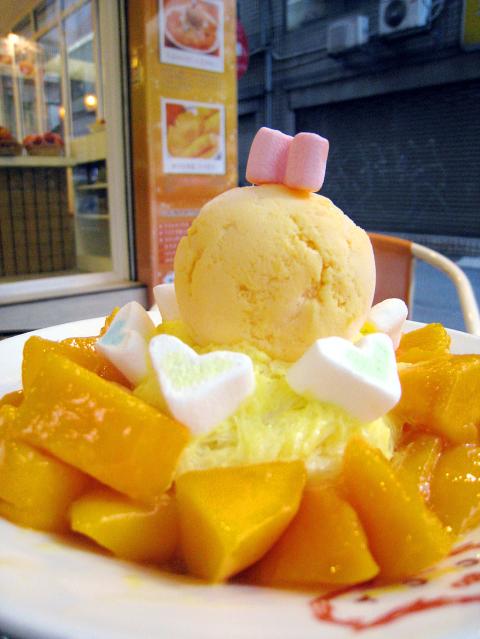Summer is in full swing, and there are few better ways to cool down than with a plate of mango shaved ice, and I’m not just talking about the immensely popular Yong Kang 15 (永康15), which occupies the spot that the legendary Ice Monster (冰館) once did. For those who have grown weary of waiting in the long queue outside that shaved ice shop on Yongkang Street (永康街), Mango ChaCha (芒果恰恰) is an equally good, if not better, alternative.
Walk into the brightly decorated shop and the scent of mangos wafts through the air, with the luscious fruit invitingly displayed in paper cartons and containers.
Proprietor Chang Chih-min (張智閩) knows the fruit well. His mangos reportedly come from orchards that produce top-grade varieties for export to Japan and South Korea.

Photo: Ho Yi, Taipei Times
But premium ingredients mean higher prices. The cheapest shaved ice item on the menu is the NT$140 mango chacha brown sugar shaved ice (芒果恰恰黑糖剉冰), which blends diced mango with a homemade brown sugar syrup.
A mango maniac’s dream come true, the mango chacha snowflake ice (芒果恰恰雪花冰, NT$200) is made from a thick layer of “snowflake ice” — a frozen concoction made from milk and the fruit that is topped with diced mango, condensed milk and a scoop of handmade mango ice cream.
This mango extravagance is delicately fragrant but isn’t cloying. And like the rest of the shop’s frozen desserts, it includes a plenteous serving of fruit.

Photo: Ho Yi, Taipei Times
Rose lover (風花雪月, NT$280), the shop’s most expensive menu option, spreads rose petals on a bed of snowflake ice and diced mango. The innovative dish is gorgeous to look at, but the petals’ aroma and flowery taste do not go well with the fruit.
Icy desserts aside, the ambitious shop has developed a whole range of mango products including mango milkshake (NT$80), mango slush (NT$100), mango jam (NT$230 and NT$380), dried mango slices (NT$60 and NT$40) and mango cake (芒果酥, NT$42 each). For tipplers, there’s mango liqueur (14 percent alcohol by volume, NT$580), which has a pleasantly sweet and smooth taste, and a mango spirit (41 percent abv) will hit the store shelf soon.
Mango ChaCha is a five-minute walk from the intersection of Guangfu South Road (光復南路) and Xinyi Road (信義路).

In the March 9 edition of the Taipei Times a piece by Ninon Godefroy ran with the headine “The quiet, gentle rhythm of Taiwan.” It started with the line “Taiwan is a small, humble place. There is no Eiffel Tower, no pyramids — no singular attraction that draws the world’s attention.” I laughed out loud at that. This was out of no disrespect for the author or the piece, which made some interesting analogies and good points about how both Din Tai Fung’s and Taiwan Semiconductor Manufacturing Co’s (TSMC, 台積電) meticulous attention to detail and quality are not quite up to

April 21 to April 27 Hsieh Er’s (謝娥) political fortunes were rising fast after she got out of jail and joined the Chinese Nationalist Party (KMT) in December 1945. Not only did she hold key positions in various committees, she was elected the only woman on the Taipei City Council and headed to Nanjing in 1946 as the sole Taiwanese female representative to the National Constituent Assembly. With the support of first lady Soong May-ling (宋美齡), she started the Taipei Women’s Association and Taiwan Provincial Women’s Association, where she

Chinese Nationalist Party (KMT) Chairman Eric Chu (朱立倫) hatched a bold plan to charge forward and seize the initiative when he held a protest in front of the Taipei City Prosecutors’ Office. Though risky, because illegal, its success would help tackle at least six problems facing both himself and the KMT. What he did not see coming was Taipei Mayor Chiang Wan-an (將萬安) tripping him up out of the gate. In spite of Chu being the most consequential and successful KMT chairman since the early 2010s — arguably saving the party from financial ruin and restoring its electoral viability —

It is one of the more remarkable facts of Taiwan history that it was never occupied or claimed by any of the numerous kingdoms of southern China — Han or otherwise — that lay just across the water from it. None of their brilliant ministers ever discovered that Taiwan was a “core interest” of the state whose annexation was “inevitable.” As Paul Kua notes in an excellent monograph laying out how the Portuguese gave Taiwan the name “Formosa,” the first Europeans to express an interest in occupying Taiwan were the Spanish. Tonio Andrade in his seminal work, How Taiwan Became Chinese,